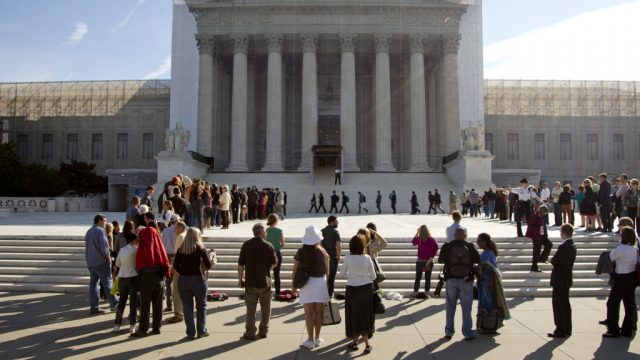Supreme Court Strikes Down Federal Oversight Of Elections

The Voting Rights Act, in part, gave the federal government authority over state elections in some jurisdictions, mostly in the south but also in states like Alaska and parts of New York too. The law was intended to stop discrimination against minority voters, and when it was challenged in the 1960’s the Supreme Court upheld it but ruled that Congress had to renew it regularly.
The last renewal, which passed Congress almost unanimously, was for 25 years. That prompted a challenge, and today the Supreme Court struck down the part of the law requiring that certain states and jurisdictions get permission from the federal government to change their election laws.
The Supreme Court’s thinking? It’s not 1965 any more, and it the federal government can’t keep acting like it is. “History did not end in 1965,” wrote Chief Justice John Roberts in the majority opinion:
(2) The Government attempts to defend the formula on grounds that it is “reverse-engineered”—Congress identified the jurisdictions to be covered and then came up with criteria to describe them. Katzenbach did not sanction such an approach, reasoning instead that the coverage formula was rational because the “formula . . . was relevant to the problem.” 383 U. S., at 329, 330. The Government has a fallback argument—because the formula was relevant in 1965, its continued use is permissible so long as any discrimination remains in the States identified in 1965. But this does not look to “current political conditions,” Northwest Austin, supra, at 203, instead relying on a comparison between the States in 1965. But history did not end in 1965. In assessing the “current need[ ]” for a preclearance system treating States differently from one another today, history since 1965 cannot be ignored. The Fifteenth Amendment is not designed to punish for the past; its purpose is to ensure a better future. To serve that purpose, Congress—if it is to divide the States—must identify those jurisdictions to be singled out on a basis that makes sense in light of current conditions. Pp. 18–21.
In other words, the federal government cannot single out specific states/jurisdictions because of discriminatory voting practices from nearly 50 years ago. Instead, the federal government must base any federal intervention into state voting policy on evidence of discriminatory practices today.
So the Supreme Court strikes down section 4 of the law, and in doing so also guts section 5 given that the former gave the latter (which gives the federal government preclearance power over redistrictong) teeth.
This ruling makes sense, and it does allow for Congress to come up with a new formula (one based on modern problems, not historical ones), but the left is reacting about as you’d expect at any suggestion that we’re not still living with the racism of 50 years ago.




